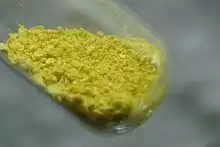Uranyl carbonate
Uranyl carbonate, UO2(CO3), is a carbonate of uranium that forms the backbone of several uranyl mineral species such as andersonite, mckelveyite-(Y) and wyartite and most importantly rutherfordine. This salt is also found in both the mineral and organic fractions of coal and its fly ash and is the main component of uranium in mine tailing seepage water.
| |||
| Names | |||
|---|---|---|---|
| IUPAC name
Uranium carbonate | |||
| Other names
Uranium Carbonate | |||
| Identifiers | |||
| |||
3D model (JSmol) |
|||
| ChemSpider | |||
| |||
| |||
| Properties | |||
| UO2(CO3) | |||
| Molar mass | 330 g/mol | ||
Except where otherwise noted, data are given for materials in their standard state (at 25 °C [77 °F], 100 kPa). | |||
| Infobox references | |||
Uranium like other actinides readily forms a dioxide uranyl core (UO2). In the environment, this uranyl core readily complexes with carbonate to form charged complexes. Although uranium forms insoluble solids or adsorbs to mineral surfaces at alkaline pH it is these soluble carbonate complexes that increase its solubility, availability, and mobility with low affinities to soil. Uranium(VI) generally forms a pH-dependent suite of uranyl carbonate and various hydrated complexes in ground water solutions.
- UO2(OH)2
- UO2(CO3)22−
- UO2(CO3)34−
- UO2(CO3)(OH)3−
A common method for concentrating uranium from a solution uses solutions of uranyl carbonates, which are passed through a resin bed where the complex ions are transferred to the resin by ion exchange with a negative ion like chloride. After build-up of the uranium complex on the resin, the uranium is eluted with a salt solution and the uranium is precipitated in another process.

The uranyl carbonate minerals
Uranyl carbonate complexes form a large class of mineral species. Several have been described in literature. These include:
- Andersonite (hydrated sodium calcium uranyl carbonate)
- Astrocyanite-(Ce) (hydrated copper cerium neodymium lanthanum praseodymium samarium calcium yttrium uranyl carbonate hydroxide)
- Bayleyite (hydrated magnesium uranyl carbonate)
- Bijvoetite-(Y) (hydrated yttrium dysprosium uranyl carbonate hydroxide)
- Fontanite (hydrated calcium uranyl carbonate)
- Grimselite (hydrated potassium sodium uranyl carbonate)
- Joliotite (hydrated uranyl carbonate)
- Liebigite (hydrated calcium uranyl carbonate)
- Mckelveyite-(Y) (hydrated barium sodium calcium uranium yttrium carbonate)
- Metazellerite (hydrated calcium uranyl carbonate)
- Rabbittite (hydrated calcium magnesium uranyl carbonate hydroxide)
- Roubaultite (copper uranyl carbonate oxide hydroxide)
- Rutherfordine (uranyl carbonate)
- Schröckingerite (hydrated sodium calcium uranyl sulfate carbonate fluoride)
- Shabaite (hydrated copper cerium neodymium lanthanum praseodymium samarium calcium yttrium uranyl carbonate hydroxide)
- Sharpite (hydrated calcium uranyl carbonate hydroxide)
- Swartzite (hydrated calcium magnesium uranyl carbonate)
- Voglite (hydrated calcium copper uranyl carbonate)
- Wyartite (hydrated calcium uranyl carbonate hydroxide)
- Widenmannite (lead uranyl carbonate)
- Zellerite (hydrated calcium uranyl carbonate)
- Znucalite (hydrated calcium zinc uranyl carbonate hydroxide)
References
- "Radioactive Elements in Coal and Fly Ash: Abundance, Forms, and Environmental Significance" (PDF). Fact Sheet FS-163-97. U.S. Geological Survey. October 1997. Retrieved 22 November 2011.
- "Ion-exchange". U.S. Nuclear Regulatory Commission. 6 October 2011. Retrieved 22 November 2011.
- Flury, Markus; Harsh, James B. (2000). "Remediation of Uranium Contaminated Mine Waste" (PDF). State of Washington Water Research Center Report WRR-04. State of Washington Water Research Center. Retrieved 22 November 2011.
- "The Uranyl Carbonates". Mineral Gallery. Amethyst Galleries. Retrieved 22 November 2011.
